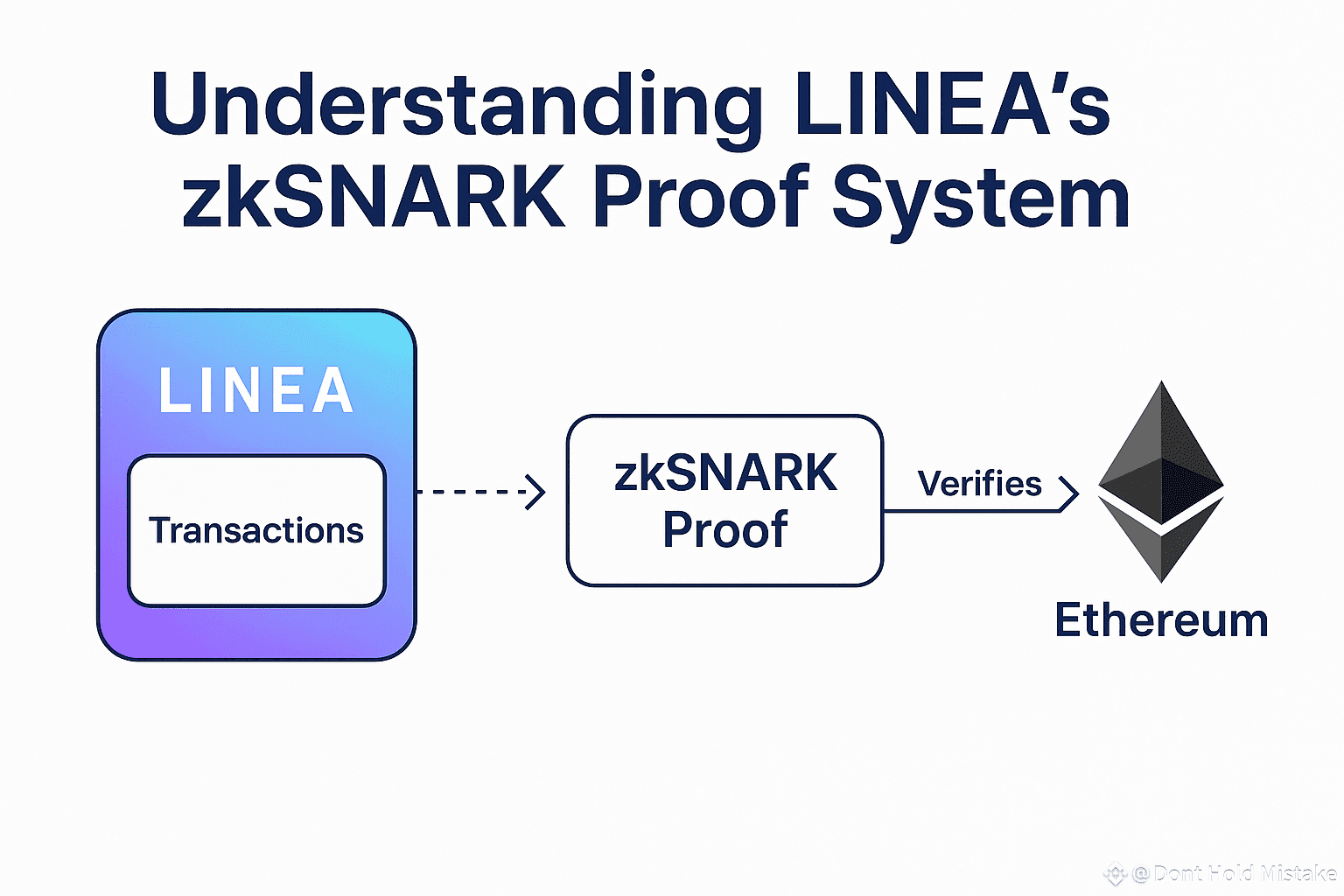When I first tried to understand how Linea’s zkSNARK proof system works, I was honestly amazed. At first glance, it seems like pure magic — transactions happening faster and cheaper, yet still fully secure. But the more I learned, the more I realized that this “magic” is actually brilliant mathematics in motion.
Linea’s zkSNARKs are one of the key reasons why its Layer-2 network can scale Ethereum while keeping users’ trust intact. Even if you’re not a developer, understanding how this works can help you feel confident that your assets and data are safe every time you use Linea.

To start with the basics, zkSNARK stands for “Zero-Knowledge Succinct Non-Interactive Argument of Knowledge.” It sounds complicated, but let’s break it down step by step. “Zero-knowledge” means that someone can prove a statement is true without revealing any additional information about it. “Succinct” means the proof is extremely small and easy to verify. “Non-interactive” means the prover and verifier don’t need to constantly communicate — everything happens in a single proof submission. Finally, “Argument of Knowledge” means the proof ensures the prover really knows what they claim to know. All of these parts come together in Linea’s architecture to make transactions verifiable, secure, and fast.
Imagine this: instead of showing every detail of a transaction to Ethereum, Linea produces a compact cryptographic proof that says, “I’ve done all the work correctly — here’s the evidence.” Ethereum can then check this proof without having to replay every step. This process drastically reduces computation and data costs. It’s like handing in a one-page summary instead of a thousand-page report — but one that’s so perfectly encoded, no one can fake it. I find this concept fascinating; it’s like compressing trust itself into a mathematical form.
In practical terms, Linea uses zkSNARKs to bundle thousands of transactions off-chain, generate a proof that all those transactions followed the rules, and then submit that proof to Ethereum’s mainnet.
Ethereum only needs to verify the proof — a process that takes a fraction of the resources compared to verifying each transaction individually.
This design allows Linea to maintain Ethereum’s security level while increasing throughput and reducing gas costs for users. The result is a network that’s as trustworthy as Ethereum, but much faster and more affordable.
One of the reasons Linea’s zkSNARK system is so efficient is its use of advanced proving algorithms and recursive proof aggregation.
Normally, generating a zero-knowledge proof for a large batch of transactions can take a lot of computational power. Linea solves this by creating smaller proofs first, then merging them recursively into one final, compact proof that Ethereum can verify. It’s like compressing a series of compressed files again — each step makes the final package smaller and easier to handle. When I learned about this recursive structure, I was truly impressed. It feels almost poetic — thousands of computations distilled into a single elegant line of truth.
Linea’s zkSNARKs also bring another crucial benefit: privacy.
Even though Linea primarily uses zk technology for scalability, the same cryptographic principles also ensure that sensitive transaction data isn’t unnecessarily exposed. This means that users can enjoy faster and cheaper transactions while still keeping their financial details private. In an age where transparency and privacy must coexist, zkSNARKs offer a perfect balance — everything is verified, but nothing sensitive is revealed.
The security of zkSNARKs relies on solid cryptographic assumptions, particularly something called elliptic curve pairing.
Without getting too deep into the math, this involves complex relationships between large prime numbers that are virtually impossible to fake.
It’s this cryptographic hardness that guarantees your transaction proofs on Linea can’t be forged or manipulated. Ethereum simply checks the proof, confirms it’s valid, and finalizes it — no trust required in any centralized actor. That’s what makes Linea truly decentralized in its verification model.
What also stands out to me is how Linea has managed to turn such a complex system into something invisible to the end user.
You don’t have to think about zkSNARKs when you send a transaction or interact with a dApp — it just works. Behind the scenes, Linea’s infrastructure generates, compresses, and submits proofs automatically. Users only see faster transactions and lower gas fees, but the real magic is the cryptography that ensures those transactions are secure. I think that’s one of the most beautiful things about technology — when complexity serves simplicity.
It’s also important to note that Linea’s zkSNARK system is part of a broader movement within Ethereum called zkEVM, which stands for zero-knowledge Ethereum Virtual Machine.
Linea’s zkEVM mimics Ethereum’s execution logic so precisely that developers can deploy their existing smart contracts without any modification. The zkSNARK proofs then confirm that the contract computations were done correctly, adding a cryptographic layer of trust that Ethereum alone could never achieve efficiently.
When I reflect on it, Linea’s zkSNARK system feels like the missing puzzle piece in Ethereum’s evolution.
It solves the scalability problem not by compromising decentralization or security, but by applying pure mathematics and cryptographic innovation.
It’s rare to see a technology that’s both so advanced and so practical for everyday users. I truly believe that once people understand what’s happening under the hood, they’ll feel as inspired as I do — confident that every transaction, every interaction, and every token transfer on Linea is backed by the strongest form of proof our digital world can offer.
In the end, zkSNARKs are more than just a technical component of Linea — they are the invisible guardians of trust, silently working behind every block.
And as someone who has followed blockchain for years, I can honestly say: I’ve never been more optimistic about Ethereum’s future than now, knowing that systems like Linea are proving — literally and mathematically — that scalability and security can finally coexist.
******************************
Follow me to learn more about the projects that truly create real value in today’s market — explained from the perspective of regular users, in the simplest and most relatable way!

